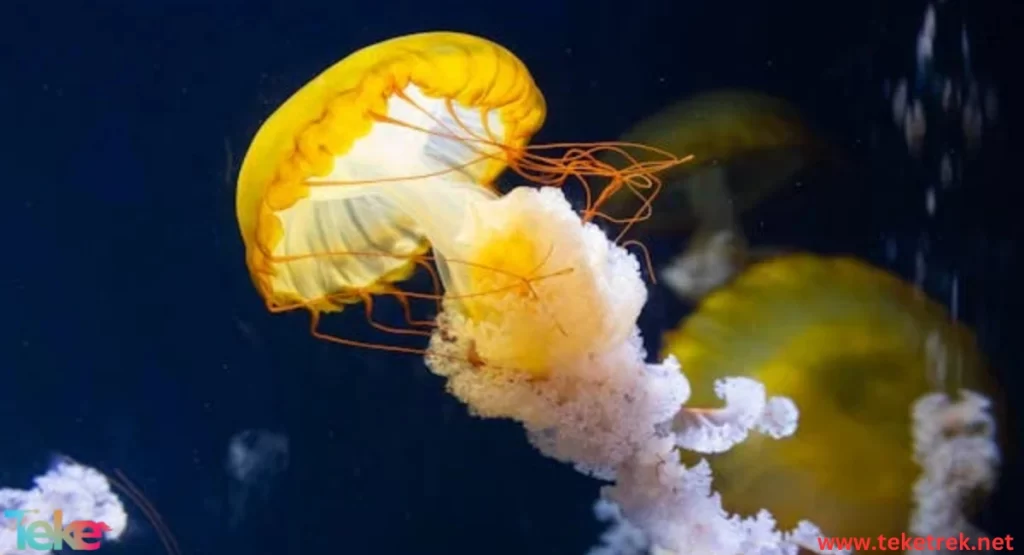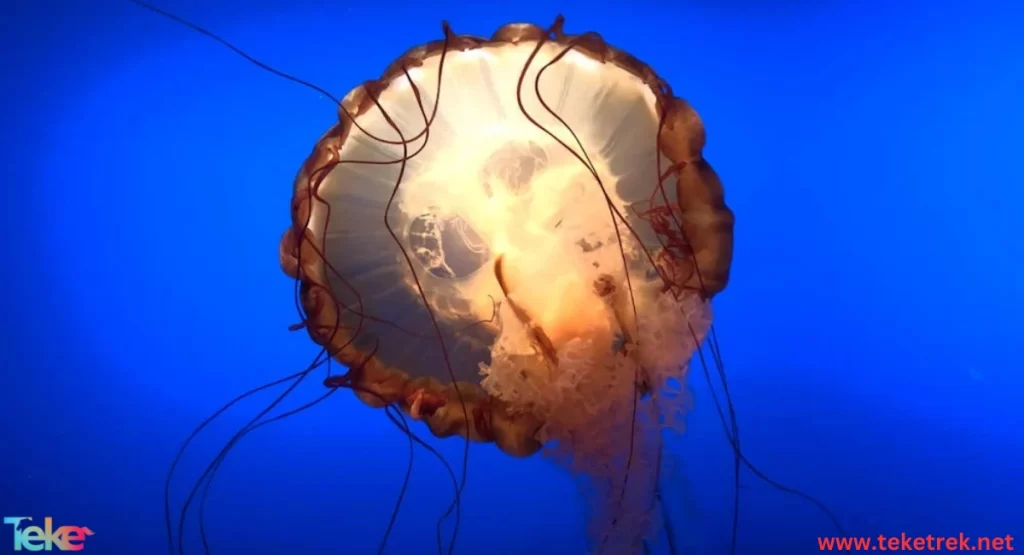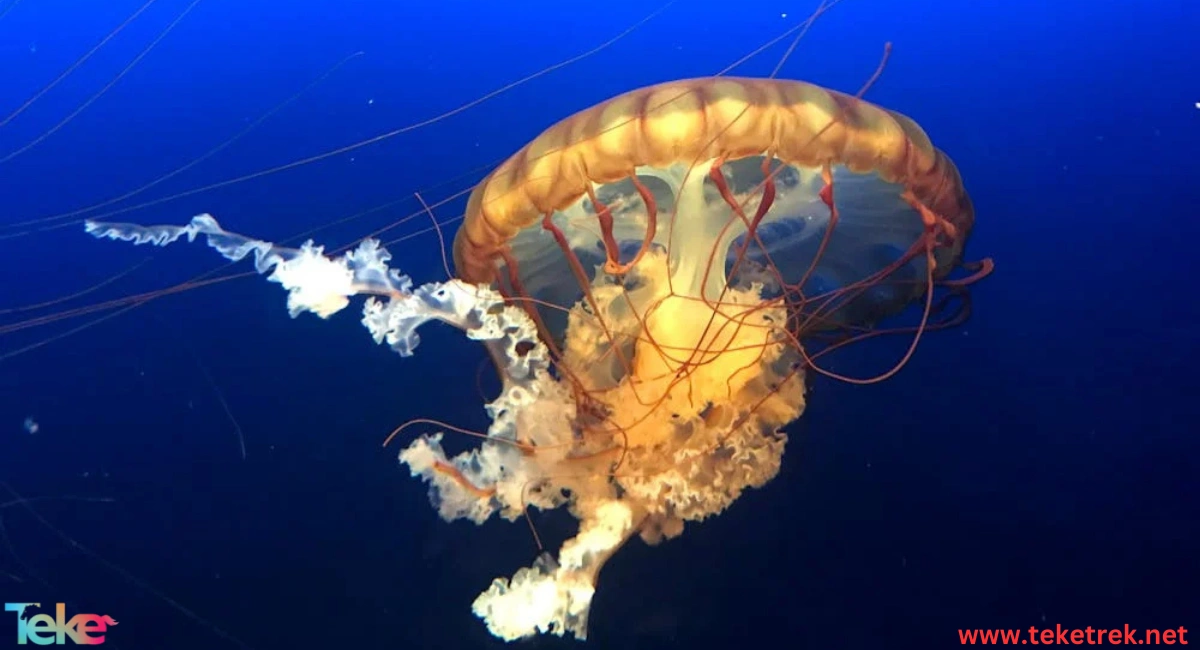The nettle jellyfish is also known as the sea nettle plant, and it is a gelatinous animal with sexual and asexual stages in its reproductive cycle.
The size and color of the nettle jellyfish vary depending on the location, and its appearance in some bays and their tributaries may result in the closure of beaches to protect people from the painful stings of the sea nettle.
Let’s learn more about it from teketrek
The nettle jellyfish belongs to the phylum Cnidaria.

Where does the nettle jellyfish live?
The nettle jellyfish is found in many marine locations, especially in coastal waters off Alaska, and as far as California and Japan. It is also found in Kamchatka and the Aleutian Islands and the Bering Sea.
This sea nettle plant is found in open oceans with high salinity, in bays with low salinity, and in brackish waters at river mouths.
What are the characteristics of the nettle jellyfish?
The nettle jellyfish is bluish-white in color with colorless warts on the surface.
The nettle jellyfish has a flattened bell-shaped dome with a diameter of up to 12 cm or more.
The nettle jellyfish has long fringed central mouth arms and 24 long tentacles, with marginal sense lobes appearing between the tentacles.
The size of the nettle jellyfish varies by location, with the bell diameter in bays and river mouths being about 10 cm and its height 5 cm.
While the diameter of the sea nettle in the open ocean ranges from 13 to 25 cm, and its height from 13 to 19 cm.
What is the diet of the nettle jellyfish?
The nettle jellyfish is a voracious carnivore, and its preferred prey is ctenophores (comb jellies) in the genus Mnemiopsis.
It also eats small fish, copepods, small clams, mosquito larvae, bay anchovy eggs, and other zooplankton.
Reproductive stages of the nettle jellyfish
The sea nettle becomes sexually mature when the bell diameter reaches about 3.81 cm.
The adult female nettle jellyfish produces eggs that are placed around her mouth with her oral arms.
The male nettle jellyfish releases sperm into the water, and the female uses her arms and oral tentacles to bring the sperm to fertilize her eggs.
A female nettle jellyfish with a diameter of 10 cm produces about 40,000 eggs daily.
Fertilized eggs sit on the oral arms until they become ciliated larvae.
Initially, the larvae are round or oval-shaped, but within two to three hours, they transform into a pear shape.
As the larvae grow and swim in the water, they become known as flat sacs.
Depending on environmental conditions, the flat sacs go through one of two reproductive stages, either asexual or sexual.
They either bud immobile copies of themselves or undergo a stage called strobilation.
Strobilation only occurs when water quality, temperature, and salinity are suitable, and food supplies are sufficient.
How do nettle jellyfish adapt to their life?
Most jellyfish prefer the high salinity of the ocean, which is 35 parts per trillion (35 parts of salt to 1000 parts of water) as their habitat.
They are adapted to living in low-salinity waters, so they live in salty estuaries.
Their numbers are influenced by the timing and intensity of spring rains and the water temperature in the Atlantic Ocean in Chesapeake Bay.
In a dry spring with warm water, ephyrae buds from the fleshy appendages that spent the winter.
When heavy rainfall runoff into river mouths reduces water salinity to less than 10 parts per million, fewer jellyfish enter the bay to breed.
How long does the nettle jellyfish live?
The lifespan is about a year, however, when seasonal heavy rains reduce water salinity to about 7 parts per million, the flat sacs remain dormant for up to two years, increasing the average expected lifespan from the polyp stage.
What is the impact of the nettle jellyfish on the environment?
These jellyfish compete for anchovies, which are an important food for bay fish.
Estimates suggest that the nettle jellyfish consume 50 percent of anchovy eggs and larvae during the peak spawning period in July, depriving other bay residents of a food source.
The Atlantic sea nettle was previously blamed for the decline of Chesapeake Bay oysters.
It was believed that they preyed on oyster larvae during the two-week period when the plankton swam freely.
Subsequent research has shown that the sea nettle is actually a protector of oysters, not a predator.
When the sea nettle swallows the larvae, it spits them out undigested.
In fact, the sea nettle preys on the comb jelly (Mnemiopsis sp.) that hunts and consumes oyster larvae.
The Atlantic sea nettle can reduce the number of comb jellies in the bay to zero in a very short time, protecting the larvae from their main predators.

Frequently asked questions about sea nettles
- Are sea nettle stings deadly?
Sea nettle stings are toxic, burning, and cause many problems, sometimes even death.
- What is a sea nettle?
The sea nettle is a genus of jellyfish with a sting that is annoying to swimmers.
- Where does the sea nettle mainly live?
The sea nettle is common on the coasts of North America and is most likely found in greater numbers around Chesapeake Bay on the east coast of the United States.
- What percentage of water is in the body of a sea nettle?
Water makes up a high percentage of the sea nettle’s body, reaching about 95% of its weight.
- How does the sea nettle move in the water?
The sea nettle moves by contracting and then extending its body, and the movement of the water current helps it travel long distances.
- What organs does the sea nettle contain?
The sea nettle contains some organs and its mouth opens in the middle, and it has many tentacles or sensory feelers.
In conclusion
, swarms of Atlantic sea nettles that appear in bays during late spring and summer months affect beachgoers and recreational boaters.
The numbers can be so large that beaches become closed.
There is no suitable method yet to control these vast numbers, as nets cannot be relied upon because the jellyfish clog them, and chemicals cause the desired fish to be killed.





